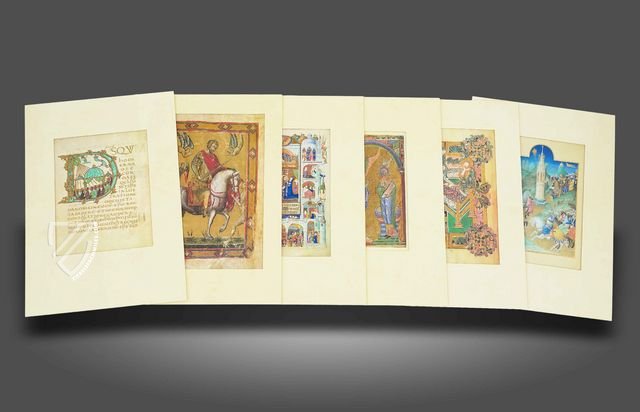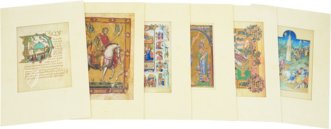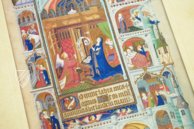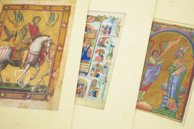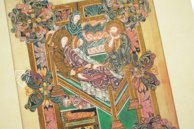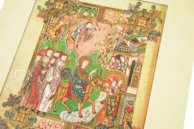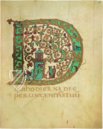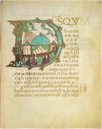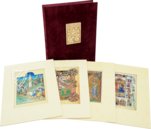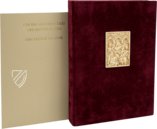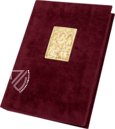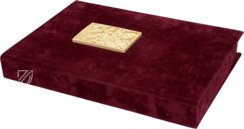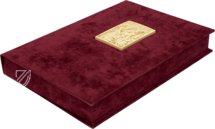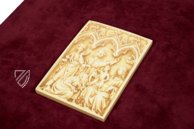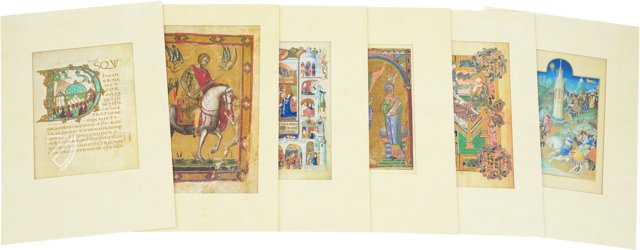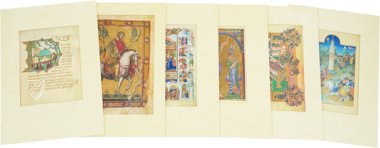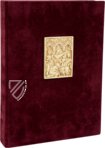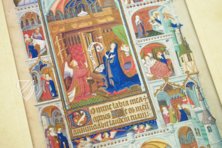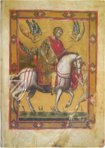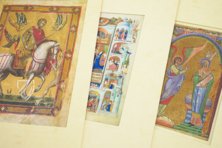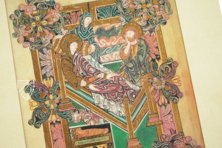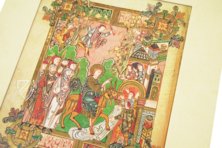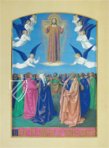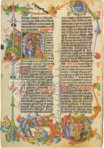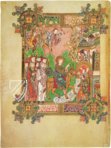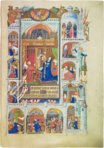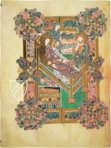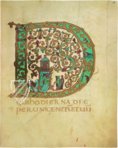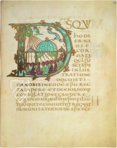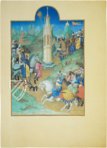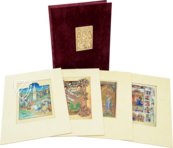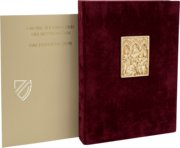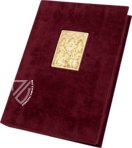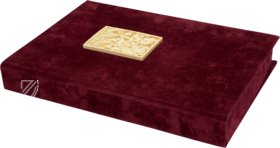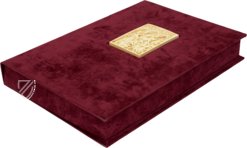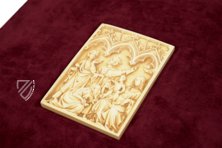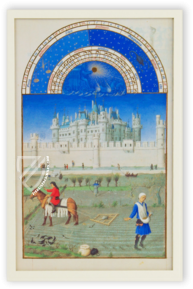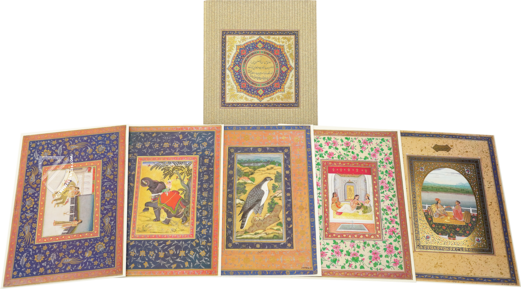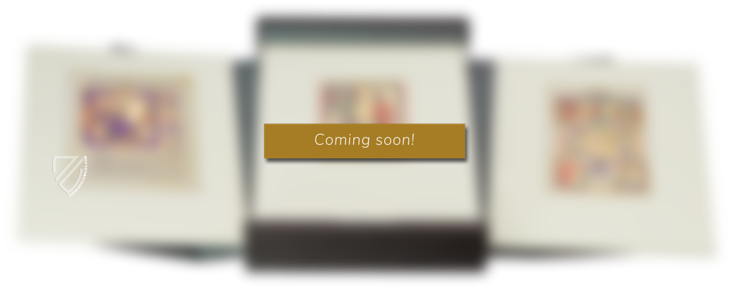The Festive Year
Just as there are holy places set aside from their surroundings like temples and churches, there are also days that are elevated above others and given special significance as festive days. Many modern Christian holidays have their roots in the European Middle Ages, a time when people's lives were still very much dependent on and influenced by nature and the miraculous-seeming change of seasons, which at that time could not yet be explained scientifically. To this day, these feast days offer a fixed routine and orientation in the recurring cycle of the years. The wonderful single-page collection The Festive Year, consisting of 10 artistic miniatures under passe-partout gathers, brings together some of the most beautiful illuminations depicting biblical stories such as the birth of Christ, which were elevated to festive days – each miniature representing a major holiday in the medieval Christian calendar.
The Festive Year
Decisive points in the solar calendar, which have been recognized in nearly every culture, including the prehistoric, have evolved into holy days. Thus, the winter solstice developed into Christmas, while Passover, from which Easter evolved, began as a spring harvest festival. Christian festivals were often placed on the days previously occupied by pagan holidays so as to make replacing them easier. The seven-day week, anchored by the sanctity of Sundays, is not only rooted in the Book of Genesis – the number seven has been associated with holiness for millennia, going back to the ancient Babylonians. The number is rooted in the seven planets and the fact that the cycle of the moon is easily divided into four, seven-day periods, even if it technically averages a little more than 29 days. It is for these reasons that the church year does not have a fixed beginning and end point with regard to the secular calendar. This compendium of ten single sheets from some of the finest manuscripts in the world, and the accompanying commentary, gives a detailed and artful survey of this fascinating topic.
Sheet 1: The Life of Mary
Bedford Hours, Paris, ca. 1423–1430
British Library, London
Sheet 2:The Annunciation at the Well
Cotton Psalter, Germany, mid–12th century
British Library, London
Sheet 2: Christmas
The Benedictional of St. Æthelwold, Winchester, ca. 980
British Library, London
Sheet 4: The Three Magi
Les très riches heures du Duc de Berry, France, 1411/1416
Musée Condé, Chantilly
Sheet 5: Epiphany (January 6th)
Missal of Archbishop Zbyněk Zajíc of Hazmburk, Prague, 1409
Österreichische Nationalbibliothek, Vienna
Sheet 6: Holy Week (Entry into Jerusalem)
The Benedictional of St. Æthelwold, Winchester, ca. 980
British Library, London
Sheet 7: Easter
Drogo Sacramentary, Metz, ca. 850–855
Bibliothèque Nationale, Paris
Sheet 8: Ascension Day
Hours of Etienne Chevalier, France, mid–15 century
Musée Condé, Chantilly
Sheet 9: Pentecost
Drogo Sacramentary, Metz, ca. 850–855
Bibliothèque Nationale, Paris
Sheet 10: St. Martin
Mother Rule of the School of St. Martin, Venice, 1362
Museo Correr, Venice
Codicology
- Alternative Titles
- Kassette Das festliche Jahr
- Size / Format
- 10 leaves / 45.0 × 32.0 cm
- Origin
- France
- Date
- 9th–15th century
- Genre
- Language
- Illustrations
- 10 elaborately illuminated pages, including 6 full-page miniatures, 4 historiated initials, and 2 historiated borders
- Content
- Ten leaves from important manuscripts
- Patron
- Jean, Duc de Berry and others
- Artist / School
- Bedford Master, Limbourg Brothers, Simon Bening and others
Bedford Hours
Life of the Virgin Mary
This wonderful architectural frame stands out among the rich décor of this French masterpiece and shows various scenes from the life of the Virgin Mary as though they were occurring within the rooms of a grand palace. Features like columns, towers, and staircases help to complete this effect and even makes it resemble an Advent calendar. Scenes include the Presentation of Mary, Visitation to St. Elizabeth, and Annunciation along with a typical medieval depiction of Mary weaving at a loom.
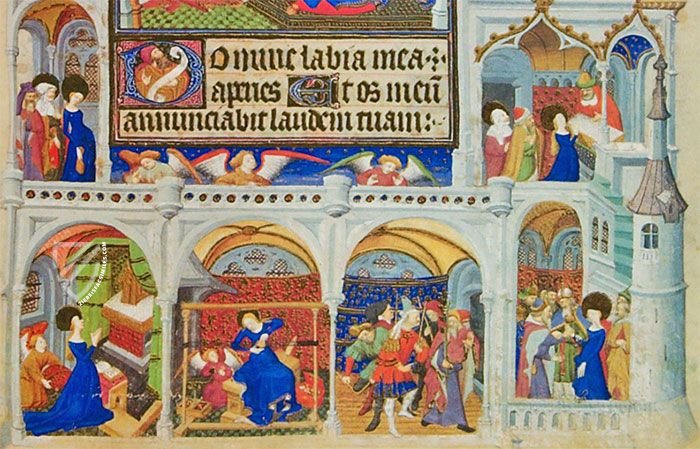
Mother Rule of the School of St. Martin
St. Martin
This 14th century miniature exhibits strong influences from Byzantine art, especially with regard to its magnificent burnished gold background, which is further embellished with fine embossing. Rather than being depicted in contemporary fashions, as was common, St. Martin is shown here in the dress of a Roman cavalryman from Late Antiquity.
According to legend, St. Martin used his sword to cut his cloak in two in order to clothe a beggar freezing in Winter. The beggar is depicted here naked but wearing a hat and holding one end of St. Martin’s fur-lined cloak, which he is about to cut with his sword. St. Martin’s magnificent horse exceeds the boundaries of the frame, the individual hairs of its mane depicted in detail.
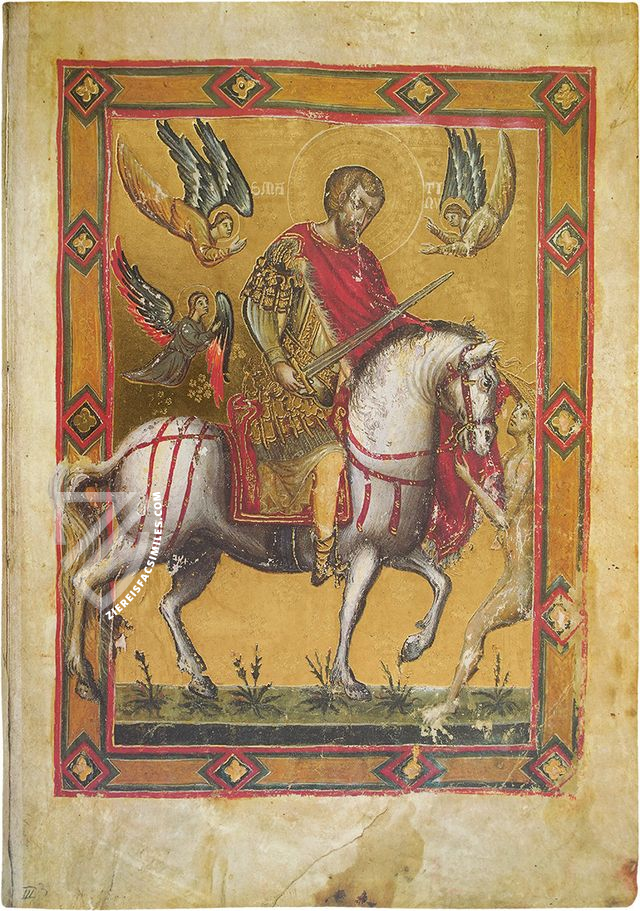
#1 Kassette Das festliche Jahr
Language: German
- Treatises / Secular Books
- Apocalypses / Beatus
- Astronomy / Astrology
- Bestiaries
- Bibles / Gospels
- Chronicles / History / Law
- Geography / Maps
- Saints' Lives
- Islam / Oriental
- Judaism / Hebrew
- Single Leaf Collections
- Leonardo da Vinci
- Literature / Poetry
- Liturgical Manuscripts
- Medicine / Botany / Alchemy
- Music
- Mythology / Prophecies
- Psalters
- Other Religious Books
- Games / Hunting
- Private Devotion Books
- Other Genres
- Afghanistan
- Armenia
- Austria
- Belgium
- Belize
- Bosnia and Herzegovina
- China
- Colombia
- Costa Rica
- Croatia
- Cyprus
- Czech Republic
- Denmark
- Egypt
- El Salvador
- Ethiopia
- France
- Germany
- Greece
- Guatemala
- Honduras
- Hungary
- India
- Iran
- Iraq
- Israel
- Italy
- Japan
- Jordan
- Kazakhstan
- Kyrgyzstan
- Lebanon
- Liechtenstein
- Luxembourg
- Mexico
- Morocco
- Netherlands
- Palestine
- Panama
- Peru
- Poland
- Portugal
- Romania
- Russia
- Serbia
- Spain
- Sri Lanka
- Sweden
- Switzerland
- Syria
- Tajikistan
- Turkey
- Turkmenistan
- Ukraine
- United Kingdom
- United States
- Uzbekistan
- Vatican City
- A. Oosthoek, van Holkema & Warendorf
- Aboca Museum
- Ajuntament de Valencia
- Akademie Verlag
- Akademische Druck- u. Verlagsanstalt (ADEVA)
- Aldo Ausilio Editore - Bottega d’Erasmo
- Alecto Historical Editions
- Alkuin Verlag
- Almqvist & Wiksell
- Amilcare Pizzi
- Andreas & Andreas Verlagsbuchhandlung
- Archa 90
- Archiv Verlag
- Archivi Edizioni
- Arnold Verlag
- ARS
- Ars Magna
- ArtCodex
- AyN Ediciones
- Azimuth Editions
- Badenia Verlag
- Bärenreiter-Verlag
- Belser Verlag
- Belser Verlag / WK Wertkontor
- Benziger Verlag
- Bernardinum Wydawnictwo
- BiblioGemma
- Biblioteca Apostolica Vaticana (Vaticanstadt, Vaticanstadt)
- Bibliotheca Palatina Faksimile Verlag
- Bibliotheca Rara
- Boydell & Brewer
- Bramante Edizioni
- Bredius Genootschap
- Brepols Publishers
- British Library
- C. Weckesser
- Caixa Catalunya
- Canesi
- CAPSA, Ars Scriptoria
- Caratzas Brothers, Publishers
- Carus Verlag
- Casamassima Libri
- Centrum Cartographie Verlag GmbH
- Chavane Verlag
- Christian Brandstätter Verlag
- Circulo Cientifico
- Club Bibliófilo Versol
- Club du Livre
- CM Editores
- Collegium Graphicum
- Collezione Apocrifa Da Vinci
- Comissão Nacional para as Comemorações dos Descobrimentos Portugueses
- Coron Verlag
- Corvina
- CTHS
- D. S. Brewer
- Damon
- De Agostini/UTET
- De Nederlandsche Boekhandel
- De Schutter
- Deuschle & Stemmle
- Deutscher Verlag für Kunstwissenschaft
- DIAMM
- Droz
- E. Schreiber Graphische Kunstanstalten
- Ediciones Boreal
- Ediciones Grial
- Ediclube
- Edições Inapa
- Edilan
- Editalia
- Edition Deuschle
- Edition Georg Popp
- Edition Leipzig
- Edition Libri Illustri
- Editiones Reales Sitios S. L.
- Éditions de l'Oiseau Lyre
- Editions Medicina Rara
- Editorial Casariego
- Editorial Mintzoa
- Editrice Antenore
- Editrice Velar
- Edizioni Edison
- Egeria, S.L.
- Eikon Editores
- Electa
- Emery Walker Limited
- Enciclopèdia Catalana
- Eos-Verlag
- Ephesus Publishing
- Ernst Battenberg
- Eugrammia Press
- Extraordinary Editions
- Fackelverlag
- Facsimila Art & Edition
- Facsimile Editions Ltd.
- Facsimilia Art & Edition Ebert KG
- Faksimile Verlag
- Feuermann Verlag
- Folger Shakespeare Library
- Franco Cosimo Panini Editore
- Friedrich Wittig Verlag
- Fundación Hullera Vasco-Leonesa
- G. Braziller
- Gabriele Mazzotta Editore
- Gebr. Mann Verlag
- Gesellschaft für graphische Industrie
- Getty Research Institute
- Giovanni Domenico de Rossi
- Giunti Editore
- Graffiti
- Grafica European Center of Fine Arts
- Guido Pressler
- Guillermo Blazquez
- Gustav Kiepenheuer
- H. N. Abrams
- Harrassowitz
- Harvard University Press
- Helikon
- Hendrickson Publishers
- Henning Oppermann
- Herder Verlag
- Hes & De Graaf Publishers
- Hoepli
- Holbein-Verlag
- Houghton Library
- Hugo Schmidt Verlag
- Idion Verlag
- Il Bulino, edizioni d'arte
- ILte
- Imago
- Insel Verlag
- Insel-Verlag Anton Kippenberger
- Instituto de Estudios Altoaragoneses
- Instituto Nacional de Antropología e Historia
- Introligatornia Budnik Jerzy
- Istituto dell'Enciclopedia Italiana - Treccani
- Istituto Ellenico di Studi Bizantini e Postbizantini
- Istituto Geografico De Agostini
- Istituto Poligrafico e Zecca dello Stato
- Italarte Art Establishments
- Jan Thorbecke Verlag
- Johnson Reprint Corporation
- Josef Stocker
- Josef Stocker-Schmid
- Jugoslavija
- Karl W. Hiersemann
- Kasper Straube
- Kaydeda Ediciones
- Kindler Verlag / Coron Verlag
- Kodansha International Ltd.
- Konrad Kölbl Verlag
- Kurt Wolff Verlag
- La Liberia dello Stato
- La Linea Editrice
- La Meta Editore
- Lambert Schneider
- Landeskreditbank Baden-Württemberg
- Leo S. Olschki
- Les Incunables
- Liber Artis
- Library of Congress
- Libreria Musicale Italiana
- Lichtdruck
- Lito Immagine Editore
- Lumen Artis
- Lund Humphries
- M. Moleiro Editor
- Maison des Sciences de l'homme et de la société de Poitiers
- Manuscriptum
- Martinus Nijhoff
- Maruzen-Yushodo Co. Ltd.
- MASA
- Massada Publishers
- McGraw-Hill
- Metropolitan Museum of Art
- Militos
- Millennium Liber
- Müller & Schindler
- Nahar - Stavit
- Nahar and Steimatzky
- National Library of Wales
- Neri Pozza
- Nova Charta
- Oceanum Verlag
- Odeon
- Orbis Mediaevalis
- Orbis Pictus
- Österreichische Staatsdruckerei
- Oxford University Press
- Pageant Books
- Parzellers Buchverlag
- Patrimonio Ediciones
- Pattloch Verlag
- PIAF
- Pieper Verlag
- Plon-Nourrit et cie
- Poligrafiche Bolis
- Presses Universitaires de Strasbourg
- Prestel Verlag
- Princeton University Press
- Prisma Verlag
- Priuli & Verlucca, editori
- Pro Sport Verlag
- Propyläen Verlag
- Pytheas Books
- Quaternio Verlag Luzern
- Reales Sitios
- Recht-Verlag
- Reichert Verlag
- Reichsdruckerei
- Reprint Verlag
- Riehn & Reusch
- Roberto Vattori Editore
- Rosenkilde and Bagger
- Roxburghe Club
- Salerno Editrice
- Saltellus Press
- Sandoz
- Sarajevo Svjetlost
- Schöck ArtPrint Kft.
- Schulsinger Brothers
- Scolar Press
- Scrinium
- Scripta Maneant
- Scriptorium
- Shazar
- Siloé, arte y bibliofilia
- SISMEL - Edizioni del Galluzzo
- Sociedad Mexicana de Antropología
- Société des Bibliophiles & Iconophiles de Belgique
- Soncin Publishing
- Sorli Ediciones
- Stainer and Bell
- Studer
- Styria Verlag
- Sumptibus Pragopress
- Szegedi Tudomànyegyetem
- Taberna Libraria
- Tarshish Books
- Taschen
- Tempus Libri
- Testimonio Compañía Editorial
- Thames and Hudson
- The Clear Vue Publishing Partnership Limited
- The Facsimile Codex
- The Folio Society
- The Marquess of Normanby
- The Richard III and Yorkist History Trust
- Tip.Le.Co
- TouchArt
- TREC Publishing House
- TRI Publishing Co.
- Trident Editore
- Tuliba Collection
- Typis Regiae Officinae Polygraphicae
- Union Verlag Berlin
- Universidad de Granada
- University of California Press
- University of Chicago Press
- Urs Graf
- Vallecchi
- Van Wijnen
- VCH, Acta Humaniora
- VDI Verlag
- VEB Deutscher Verlag für Musik
- Verlag Anton Pustet / Andreas Verlag
- Verlag Bibliophile Drucke Josef Stocker
- Verlag der Münchner Drucke
- Verlag für Regionalgeschichte
- Verlag Styria
- Vicent Garcia Editores
- W. Turnowski Ltd.
- W. Turnowsky
- Waanders Printers
- Wiener Mechitharisten-Congregation (Wien, Österreich)
- Wissenschaftliche Buchgesellschaft
- Wissenschaftliche Verlagsgesellschaft
- Wydawnictwo Dolnoslaskie
- Xuntanza Editorial
- Zakład Narodowy
- Zollikofer AG

